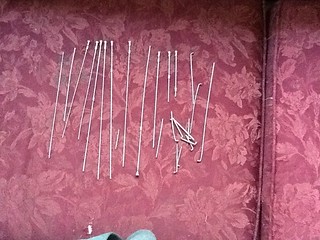The learning curve
I pulled one of my early wheels off the project bike and sat down this morning to retrue it and try to get one largish bump out of the rim. That bump had been there for a long time, and when I built the wheel in the first place I did some heroic measures to try and work the bump out, but unfortunately I didn’t really know what I was doing then, so the heroic measures meant “tighten the devil out of the spokes around the bump.”
This had the undesirable side effect (I’m not counting the rounded and twisted spokes here) of basically welding the spokes to the nipples, so when I atttempted to detension them the nipples simply shattered on me, which meant I had to cut out the offending spokes and replace them (with old spokes from my old spokes bin, which were more or less the right length. )
I did manage to true the wheel and get most of the bump out, which is something – it’s probably more important that the wheel be true than it being totally circular – but I’m happy I’ve got 14 more wheels under my belt and I don’t make the same sort of mistakes I was making early on.
Comments
Oh, yeah, and you do use boiled linseed oil on the spoke threads as combined anti-seize and thread locking?
Seems to make a big difference when adjusting tension later.
No, I don’t use linseed oil – I use teflon-impregnated grease to lubricate the threads, and friction to hold the spokes in place. It works well enough; I don’t think I’ve needed to true the dynowheel on the midlifecrisismobile in the last 16,000 miles (and now the rim is worn concave enough so that I’m going to have to replace it in a thousand miles or so; that’s why I’m building up a H+Son Archetype/PV-8+Angry Bee wheelset.)
Friction works, yeah, but it’s also what the folks who run the wheelbuilding course I took identify as a cause of busted spokes on re-truing; they were big into greasing the nipple seats in the rim, too.
That’s somewhat bizarre; they imply that friction causes spoke breakage when truing a wheel, so they recommend increasing friction by applying thread lock?
It’s a very specific sort of light thread lock they mean. (There are a couple of commercial ones but the boiled linseed is the only thing I’ve seen actually advocated; it’s cheap and it does the job, even if there’s a rag-disposal issue due to the spontaneous combustion risk.)
The idea, as I understand it, is that you use the appropriate light thread lock and greased nipple seats when you build the wheel; this means you are less at risk of getting twisty spokes (though you still have to check!) since the thread lock hasn’t set yet and is acting as a lubricant and the nipples aren’t as likely to stick against the rim as they come up to full tension. The argument is that such a wheel is a more stable wheel, both because spokes twisted during lacing don’t abruptly untwist under load, mangling the overall wheel tension, and because the nipples aren’t likely to turn if briefly de-tensioned due to load because of the thread lock, which has had time to set and keep things from moving.
When you go to re-true the wheel in the fullness of time, the lightness of the thread lock means it doesn’t hold very hard when you go at the nipple with a spokey; it’s not like using red loctite or anything. And because there’s the layer of thread lock in there acting as anti-seize, you have less to worry about in the way of corrosion welding the nipple to the spoke, so the thread lock is the only resistance you have to overcome.
So far as my limited experience permits me to tell, there’s definitely something to all of these points.
Comments are closed

Everything I’ve ever seen about this suggests that some rims cannot be made either true or round; if the thing isn’t made right there’s not necessarily something you can do with spoke tension to fix it.
The course I took had < 1mm +/- deviation from round, and less than half a millimetre plus-minus out of true for a passing mark. I don’t know how common that is. (Round is tougher because there’s always the weld seam where the rim was joined.)
The Peter White wheels I’ve ordered have shown up true to +/- 0.1mm. I tend to think one can’t hope to do better than that. (I managed +/- 0.25mm, though not in a commercially viable time frame, let’s say.)